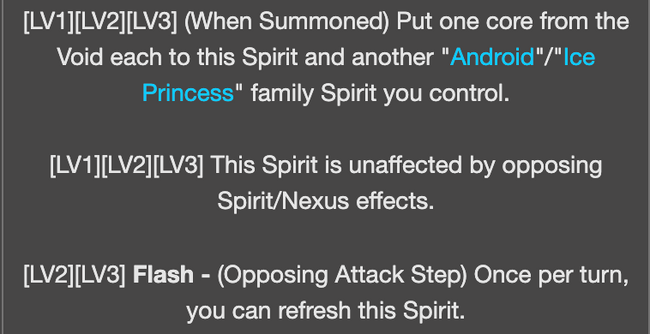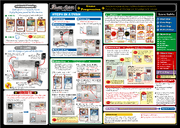
Rule Sheet
Welcome to Battle Spirits! Gate open, release!
This page details the basic how to turn-by turn explanations of the game as well as detailing how to use different types of cards.
For detailed rulings about playing, please refer to Official Rulings Q&A.
Types of Cards[]
Spirit: Spirits are summoned mainly to attack the opponent and reduce their life but are also used to protect your own life by blocking.
Nexus: These are cards that can remain on the field permanently until an effect removes them. Players use them to change the board state and gain advantages over the opponent. In lore, Nexuses represent the places that Spirits stay.
Magic: Used to called "Spells" in the official English release. Players use Magic to change the game field environment by causing a variety of different effects from providing BP boosts to drawing more cards to removing cards on the field. They can drastically change the pace of the game.
Brave: A fourth card type introduced about two years after the game first launched. They act like Spirits, but can be braved (in simpler terms, equip) onto other Spirits, combining BP, effects, colors, costs, and symbols.
Ultimate: A fifth card type introduced in late 2013. Ultimates are similar to Spirits, but aren't treated as such. Most have higher levels and BPs than the Spirits. Ultimates require summon conditions to be met in order to summon them, typically needing another Spirit of a certain color or cost on field or life at a certain number. All Ultimates have a star symbol that does not represent any colors rather than a colored symbol.
Key Features of a Card[]
Using a Spirit card as an example, this section will explain some of the main features of a card.
Cost: Every card must have its cost paid before it can be used. The cost is the number in the top-left corner of the card. To pay the cost, a number of cores from the Reserve or Field (cores on the cards) equal to the Core Cost are sent to the trash. Cores in the trash can't be used to play cards, unless effects allow so.
Cost Reduction: Represented by the spokes to the right of the core cost, which shows how much the cost can be reduced by. For each symbol on field that corresponds to the cost reduction symbol, the cost can be decreased by 1. Using the image about as an example, you're going to summon a Cost 4 Spirit with two red reduction symbols. On your field you have a Spirit with one red symbol (indicated by the large symbol at the bottom right of the card). You'll summon the Cost 4 Spirit at 3 costs, as 4-1=3. Using the same Spirit as an example again, do note if your field has red symbols more than the reduction symbols indicate (in this case 2 reduction symbols), you still only get to -2 costs at most. The Cost Reduction is a must-use feature, not an optional one. You must pay the cost as least as possible.
Type of Card: Indicates what card type the card is.
Name of Card: Name of the card. For more information, check Card Name.
Family: Each Spirit/Ultimate/Brave is always assigned to at least one family, which acts as a unification for cards. Since the end of Ultra Advent Saga, some Nexuses also have families. Families can also be assigned to any card types through effects. One deck can also contain cards from multiple families. For more information, check Family.
Lv Cost: After paying cost and placing a card onto the Field, a card must have enough cores place on it equal or more than its Core Number of Level 1 Cost to stay on field and complete their summoning (all effects related to the summoning can only activate after placing enough cores for the specific level). Most Spirits, Braves, and Ultimates have "Level 1: 1 core", which means they need at least one core to stay on field (but some have "Level 1: 2 cores", which means they need at least 2 cores). And most Nexuses have "Level 1: 0 cores", making them able to remain on the Field at 0 cores.
Lv BP: The BP the Spirit/Ultimate/Brave has at the level that's with the BP.
Effect: Additional effects of the card, which can be compulsory or optional to activate. Most effects have levels indicated at the start, meaning that the effect can only activate if the card is at that level. For example, if a Spirit has the effect "[LV2] (When Attacks) Draw a card.", that means it allows you to draw a card when it attacks at LV2, but the effect won't activate if it attacks at LV1.
Symbol: Indicated by the large symbol at the bottom right corner of the card. When a Spirit/Ultimate attacks and the opponent chooses to take life for the attack, the damage done to the opponent is equal to the number of symbols on the attacking Spirit/Ultimate. As mentioned above, symbols are also used to fulfill reduction symbols.
Attribute (Color): Mainly just called color now. Each card always has a colored border, and the colors contained in the border are the colors that the card has. There are six colors in the game: Red, Purple, White, Green, Yellow, Blue. Take note that the color of the symbol on a card doesn't represent the card's color, and isn't equivalent to the color of the border. When an effect refers to the card's color, it always refers to the border color, not the symbol color.
Card Details:
- Block icon: Starting in Ultimate Saga, block icon is printed on cards as a diamond containing a number. Block icons have two colors: light blue meaning the card is from main sets, and orange meaning the card is from collaboration sets. Tournaments may limit players to use cards of only one block color.
- Block number: the number within the block icon. Starting from the Ultimate Saga as <1>, the block number gets +1 as each new era starts. For example, if a card was released in Ultimate Saga, then the block number on it would be <1>. If a card was released in the Burning Soul Saga, which is the saga right after Ultimate Saga, the block icon on it would be <2>. Tournaments may limit players to use cards of only certain block numbers. As such, popular cards are frequently reprinted in order to update their block numbers, so they can be used in newer tournaments.
- Rarity: Indicates how rare a card is. For more information, check Card Rarity.
- Card Number: Indicates where the card is listed in its own set. For example, if a card is listed as the 28th card in set 1, then its card number is BS01-028.
Game Mat[]
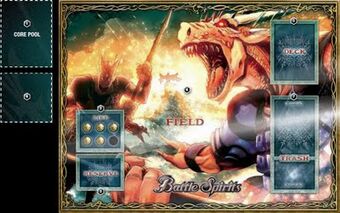
Gameplay Mat (2008)
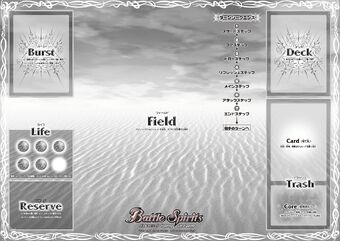
Gameplay Mat (2015)
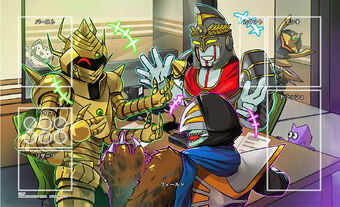
Gameplay Mat with Counter Area
- Void: Used to called "Core Pool" in the English release. This is placed outside of the game mat, and is where cores not currently in play are kept.
- Life: Where the cores representing your life are put.
- Reserve: Where cores in play, but not being used, are kept.
- Field: Where cards in play are placed.
- Hand: The cards that you currently hold, but are not in play.
- Burst Area: Cards with the Burst effect are set here face down until their condition is fulfilled and they are activated. Only one Burst card can be set at a time, and only cards with Burst effects may be set. During Main Step, the turn player can discard their own Burst to set a new one. However, if they're not going to set a new one, they can't discard their own Burst without through effects. As of True Rebirth Saga, cards with the Mirage effect can also be set here face-up. Only one Mirage card can be set at a time, but it can be set together with a Burst card. Same as Burst, during Main Step, the turn player can discard their own Burst to set a new one; though unlike Burst, Mirage cards are switched in places when a new one is set.
- Deck Zone: Where the deck is placed.
- Removed Zone: Where cards removed from game are placed. It is located besides the Void. Despite the name, removed from game cards can be played normally during the game. It's also sometimes called the Open Zone.
- Core Trash: Where cores used up when paying cost are placed.
- Card Trash: Where discarded, depleted, or destroyed cards are placed.
- Counter Area: An area introduced in the Rebirth Saga. When a Rebirth card (a two-sided card) flips from its front side to the back side, typically it has an effect to gain one core from the Void to the Counter Area. Cores in the Counter Area can't be removed, nor can a player normally move cores to it without the help of effects.
Other Terms[]
- Cores: Tokens that allow you to use cards. If you don't have enough cores to pay the cost of a card, or to maintain a card at its minimum level, the card can't be used. Similarly, if there aren't enough cores to pay the cost of an effect, the effect can't be used.
- Soul Core: A new type of token introduced in the Burning Soul Saga in 2015 (SD29 then BS31). Soul Core is a different core that can activate many effects related to it. Every player can have only one Soul Core during a game and it can't be sent to the Void by the opponent. Only the owner can remove it from a game by the effect of Soul Drive. Similarly, Soul Core can't be moved to the Life unless through a "Seal"-named effect.
- Refreshed: A card in upright position. A refreshed Spirit/Ultimate can attack/block.
- Exhausted: A card in sideways position. An exhausted Spirit/Ultimate can't attack/block.
- Heavy Exhausted: A card in upside-down position. A heavy-exhausted Spirit/Ultimate can't attack/block. When refreshing once, it goes to the exhausted state.
- Destroyed: A destroyed card is moved to the trash and the cores on it go to the reserve.
- Depleted: A card that does not satisfy its LV1 cost is treated as depleted and is sent to the trash.
- Burst: Action of trap cards that activates when certain conditions are met. Each Burst card have an effect that can be activated without paying the card's cost, and typically can activate another if the cost is paid.
Game Preparation[]
A deck must contain at least 40 cards, but has no upper limit. There is a limit of 3 cards of the same name per deck. However, some cards may be restricted, banned, or have unlimited copies allowed.
The set ups needed are as follows:
- Ready all your cores into the Void.
- Shuffle your deck.
- Place that deck in the deck zone.
- Place 5 cores in your Life.
- Place 4 cores, one of them being the Soul Core, in your Reserve.
- Draw 4 cards from your deck to your hand.
- Decide who goes first in any ways you and your opponent prefers. The winner will decide who goes first.
How to Win[]
- Reducing your opponent's life to 0.
- Your opponent has 0 cards in their deck during their Start Step.
Turn Order[]
All steps can't be skipped even if the player does nothing during them.
1. Start Step
Any effects that are activated at the start of the turn are activated in this step. Or else, it's simply the step to declare the start of the turn.
2. Core Step
You gain 1 core in your reserve from the Void. The player starting the game skips this step on their first turn.
3. Draw Step
Draw 1 card from your deck.
4. Refresh Step
Refresh all your exhausted cards. Then, move all the cores from your trash to your reserve.
5. Main Step
Player can do any move in the following during this step:
i) Summon a Spirit/Ultimate/Brave - Pay the cost of a Spirit/Ultimate/Brave card in your hand/removed zone and summon it.
ii) Deploy a Nexus - Pay the cost of a Nexus card in your hand/removed zone and deploy it.
iii) Play a Magic card - You may play a Magic card with (Main) or (Flash) timing from your hand/removed zone by paying its cost.
- Adding to that point, you can activate any effects that has the "flash" word in timing, as long the effect doesn't specify other timings (e.g. Change).
iv) Level up and down cards on field - The amount of cores you need to bring the cards to each level is indicated on the left on the left side of their text. Core can be moved onto cards in any amount.
v) Set down a Burst/Mirage at most once per turn each.
6. Attack Step
In an Attack Step, the turn player can attack as many times as the cards/effects allow him to.
However, the Attack Step is skipped in the first turn of the player starting the game. The second player can choose whether to launch attacks on their initial turn (the second turn of the game). There are many procedures in one Attack Step, as explained in the following:
- Declare an attack: The turn player selects one of their refreshed Spirits/Ultimates and attacks with it by exhausting it (turning it sideways). If the attacking Spirit/Ultimate has any effects with the timings "When Attacks" or "When Battles", the player must activate them. If the effects are optional to activate, the attacker must choose to use or not before the blocker activates their Burst or before Flash Timing.
- Flash Timing 1: The blocker will get a chance first to use an effect with the (Flash) timing, or pass. Then the attacker will get the chance or pass too. If the attacker has used a flash effect, then the blocker will get a chance again and so on. Flash step will be ended if neither player declares flash.
- If the blocker isn't blocking, skip to (6).
- If the blocker is blocking, continue to (3).
- Declare Blocking: The blocker can select 1 of their refreshed Spirits/Ultimates and block with it by exhausting it. Effects with the timings "When Blocks" or "When Battles" activate at this timing. If the blocker can't block or chooses not to block, Flash Timing 2 will be skipped.
- Flash Timing 2: (exists after block) Same as Flash Timing 1.
- BP comparison: If the blocking player blocks the attacking Spirit/Ultimate, compare the BP between the attacking and blocking Spirits/Ultimates. The Spirit/Ultimates with lower BP gets destroyed. If the BP is equal, it results in a draw and both are destroyed.
- Taking Life: If the blocker isn't blocking, then the attack aims at the blocker's Life, and the blocker moves number of cores from his Life to the Reserve equal to the number of symbols on the attacking Spirit/Ultimate.
- End of Battle: Happens after BP comparison is resolved, or after Life is taken. Many effects will happen at this time.
If a Spirit/Ultimate target attacks an opposing Spirit/Ultimate, the targeted Spirit/Ultimate must block immediately, and Flash Timing 1 is skipped in that battle.
The Attack Step ends if the turn player doesn't make anymore attacks.
7. End Step
Any effects that are activated at the end of the turn are activated in this step. Or else, it's simply a step to declare the end of the turn.
Dual Battle[]
Please refer to the page How to Play/Dual Battle. Do note that the format is officially abandoned so there will be outdated rules on the page.
Conventional Rules[]
Activating Effects[]
During each step, there will always be cards activating their effects. The effects come with all kinds of varieties, some are permanent, some are mandatory to activate, some are optional etc. Activating an effect doesn't need to pay any cost, but the effect itself may require to do so, or it has other conditions to be fulfilled. Take Valkyrie Sliema as an example, it has three effects:
The first effect is a (When Summoned) effect which activates automatically when the Spirit is summoned, a mandatory effect. The second effect is a permanent effect with no specific activation timing, its effect is active once the Spirit is summoned. The third effect is an effect which is optional to activate during the Flash Timing of the opposing Attack Step, and is limited to once per turn.
Multiple Effects Activating at the Same Time[]
When two or more effects activate at the same timing, effects which are "always active during game/turn or between steps" (A) are prioritised to be resolved over effects which require a specific timing to activate (B). When either multiple effects A or multiple effects B are activating at the same time, the turn player decides the resolve order. When this happens, and the first effect in order triggers more effects, the triggered effects are prioritised over the rest of the effects in the original order.

